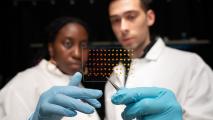If humanity is going to colonize other planets, we probably have to start with Mars. But the North Pole is balmy by comparison with the Red Planet, and the surface of Mars makes Earth’s radioactive Lake Karachay look like a country spa. The solution, some futurologists and scientists believe, is to terraform Mars — transform the planet until it is more capable of supporting human life.
It’s a mammoth task. Mars is lethal in multiple ways. If you were to be teleported this moment to Mars, in the clothes you’re wearing now, the gas in your bloodstream would turn into bubbles. Like a shaken can of Coke, you would fizz to death. If somehow you avoided that, you would soon die of oxygen deprivation, cold exposure, or radiation poisoning.
Ultimately, a terraformed Mars would need a strengthened magnetosphere – the protective magnetic layer that shields Earth from the Sun’s ultraviolet radiation – and a thicker atmosphere. That atmosphere is currently almost entirely composed of carbon dioxide, with negligible amounts of oxygen. The planet would also need to be much warmer; its surface temperature is, on average, -81 degrees Fahrenheit.
If we managed to warm the planet up, we’d release frozen CO2 reserves at the planet’s polar caps and elsewhere. That would help thicken the atmosphere, making it possible for water, rather than ice, to exist on the surface – conditions that would make it easier to introduce plants, which produce oxygen. But how would we even start that warming process?
Musk proposes “a continuous stream of very low fallout nuclear fusion explosions” above Mars.
Elon Musk has repeatedly suggested that we nuke Mars. We’d do this, he suggests, by creating “a continuous stream of very low fallout nuclear fusion explosions above the atmosphere to create artificial suns.” This could warm the planet, melt the frozen CO2 ice caps, and thicken the atmosphere, causing even more warming. Even if there were enough frozen CO2 to melt, this strategy would involve an almost infeasible number of nuclear weapons.
There are other proposed strategies for Martian global warming, such as the diversion of asteroids into the poles, and the production, on a massive scale, of CFCs (chlorofluorocarbons) – potent greenhouse gasses that are horrible for Earth’s ozone layer but which would help heat Mars. Another idea involves the creation of a huge space mirror as large as the side of Mars, reflecting vast amounts of additional sunlight onto the Red Planet.
These proposals involve huge costs and inventing new technologies.
These proposals would require huge costs and significant upgrades in human technological capabilities. Is there a cheaper, easier way of beginning the terraforming process? Casey Handmer thinks so.
Handmer, formerly of NASA’s Jet Propulsion Laboratory, is now the founder of a startup that seeks to create carbon-negative natural gas by sucking CO2 out of Earth’s atmosphere. He also publishes a space blog, where he outlined a proposal that he argues could, at the modest cost of $10 billion, make significant progress towards terraforming Mars.
Speaking to Freethink, Handmer explained his idea: mass producing small solar sails. Solar sails are an existing (albeit nascent) technology; they use the Sun’s light to propel themselves just as a ship sail uses wind.
The sail devices would be launched up into low Earth orbit, and would then fly themselves to Mars. There they would reflect sunlight onto the night side of the planet. A decade of these launches could, according to Handmer’s calculations, result in a 1% temperature increase.
“You could mass-produce relatively inexpensive solar sails using cell phones’ supply chain.”
“It seemed to me that you could mass-produce relatively inexpensive solar sails using cell phones’ supply chain,” he argues. “We produce hundreds of millions of them per year.”
Why cell phone factories? These solar sails, he writes, would, like phones, need a processor, a camera (for navigation), and the ability to transmit data. In harnessing cell phone electronics, they would resemble Nasa’s existing PhoneSat project, which takes the form of small satellites that use cell phone technology.
The sails would also need an LCD panel to steer the sail by shining light into it, as well as a solar photovoltaic cell to power it. And, of course, each of these devices would require the sail itself: a thin space blanket that would weigh a kilogram and would, when unfurled, span about the size of two basketball courts.
Building these devices on Earth sidesteps the multiple engineering challenges that would affect manufacturing on Mars. “If you can solve the problem on Earth, you should solve the problem on Mars,” says Handmer.
“Starship would be more than capable of launching essentially arbitrary quantities of these…”
Aside from taking advantage of the modern world’s efficient cell phone industry, Handmer’s proposal relies on the tumbling cost of bringing cargo into space. “A launch vehicle like Falcon Nine, Falcon Heavy or Starship would be more than capable of launching essentially arbitrary quantities of these (solar sail devices) into higher ends of low Earth orbit,” he says.
Would this plan enable us to terraform Mars, to a significant extent, within our lifetimes? Handmer says, “The short answer is ‘No.’ I think if you put enough money into solar sails, you can make it warm and possibly wet.”
Quite aside from the feasibility of such a massive project, any terraforming plan opens a host of thorny ethical questions. Who gets to decide whether to do it, or how? Who counts as a stakeholder? What if there’s indigenous microbial life that the terraforming activities would disturb or kill? Handmer, however, sees terraforming as a mission whose importance outweighs other considerations.
“I think it’s pure upside to expand the scope of our ambition, of what we are prepared to achieve, and basically leave a more expanded range of human experiences and possibilities for our descendants, rather than for example, saying, ‘Well, we could, but we won’t, so f— it,’ and then, in three generations or so, losing that ability, or forgetting how to do it. That would be pretty dismal, I think.”





